Gardening WITH Slugs?!
Theme: Love is the Slug – Fuzzboz
Introduction
2024 – they year of the slug! None of the seeds I sowed in the ground grew. The seedlings I cared for in my polytunnel were happily snacked upon. Even some perrennial plants succumbed to the molluscs as soon as their leaves appeared.
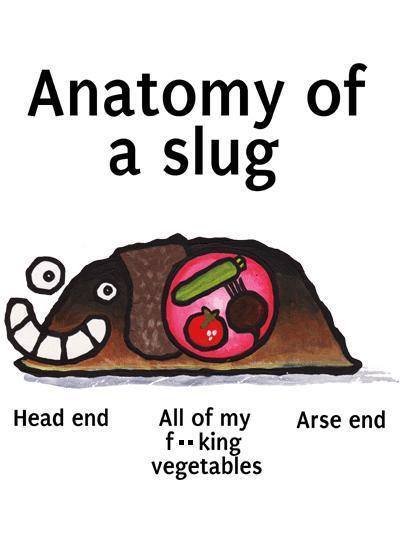
I’m just focussing on the slugs in this design. The voles & rodents who happily ate over 200 crocus bulbs, the moles that tunnelled, the Deer that munched shrubs and rogue chickens and pheasants that scratched things up aren’t covered. Miraculously the badgers and rabbits haven’t made it much plant damage (yet).
Warning – Slugs were harmed in the process of this design and there is a graphic photo of dead slugs
Ethics
Earth Care –
People Care –
Future Care –
Principles used to guide design
Mollison 1 – Work with nature not against it, The problem is the solution, Make the least change for the most effect, Yield is theoretically unlimited, Everything gardens.
Design Framework – Web of Principles
James Chapman’s Simplest Design Framework.
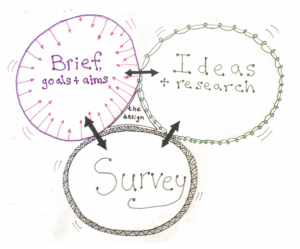
Client
Myself – a personal project (however, I will share with any slug ridden gardeners)
Dates
August 2024 – September 2024 – A quick design!
Tools Used
- Observation & Knowledge of the site
- Rose, Thorn, Bud analysis
- Slug survey & trapping
Resources Used
- James Chapman’s Simplest Design Process
- The Little Book of Slugs – Allan Shepherd and Suzanne Galant
- How to stop slugs and snails / RHS
- Random Internet searches for “Slug Proof Plants”
- RSPCA Website
Yields this project will provide and links to Personal Objectives
gshdgadgjs
Brief
To have a toolkit of ideas to implement in order to be able to grow some annual veg and some beautiful flowers.
To have a list of plants that slugs don’t like that, that can either be eaten (by humans), or provide another use.
To create a workable implementation plan and to use these ideas in my veg garden, in my bird food garden, polytunnel and greenhouse, as well as other areas on the farm.
Ideas
A brain dump of ideas to explore further as I go through the process (determined not to leap to any conclusions – for once).
| Encourage natural predators – frogs, toads, beetles, hedgehogs | Barriers – copper, fleece, hair, moats, egg shell, grit |
| Traps – liquid, solid, bait | Purchased products – natural slug pellets, nematodes |
| Ducks | Manual removal or instruments of death |
Survey
As I am familar with the site, I wanted to use a survey process that would ensure I didn’t become presumtous in my knowlege. I used Patrick Whitefields 4 Stage Observation, which as James Chapman says is “a great way to start your design off”
Stage 1 – First impressions and context of the site.
Stage 2 – What was the site like before I started cultivating & what will the site be like if I leave it alone?
Stage 3 – Go to your favourite spot and do something creative
Stage 4 – Start listing plants, take photos, analyse soil, make maps, ‘interview” slugs
Stage 1 – First impressions and context of the site
I don’t want to focus on a single growing area, so I am keeping observations quite general across the entire cultivation spots (veg plot, bird food garden, polytunnel, greenhouse)
The climate is generally damp, with high humidity. Beds are mulched in the spring using home made compost and rotted horse or cow manure and were made using no-till methods. The sites are enclosed using dry stone walls. There are young trees. There are semi-mature fruit shrubs and a significant amount of comfrey. Docks, Coltsfoot, Nettles and Couch grass are the main problem weeds. The sites are surrounded by fields, some with hedgerows as well as young trees.
Stage 2 – What was the site like before I started cultivating & what will the site be like if I leave it alone?
When I first took on the site it was rough grazed pasture. The site above the house had very thin, stony soil. If I left it alone, the trees and bushes would continue to grow. I imagine Nettles, Couch Grass, Coltsfoot, and the Comfrey would continue to grow. The Willow herbs would spread further into the area. The fruit bushes would eventually become swamped by the taller weeds. The soil would continue to slowly build. Brambles would move in.
Stage 3 – Go to your favourite spot and do something creative
I like to sew. This is one of my happly places. I made a long pair of blue culottes. They fitted, but looked ridiculous!
No picture of the offending garment – perhaps I will wear them to embarass the kids? In the mean time they are in the pile of things to turn into something else.
Stage 4 – Start listing plants, take photos, ‘interview” slugs
I split the plants into three categories.
| Plants that slugs demolish | Plants that slugs eat, but survive | Slugs don’t seem to eat these |
| Calendula, Poppy, Brassicas, Carrots, Parsley, Chard, Turnips, Courgettes, Squash, Cucumber, basil, Sunflowers, Climbing Beans, Bush Beans, Rudbeckia Anything planted from seed | Beetroot, Turkish rocket, tomato, mallows, peas (destroyed by rodents), Wild Strawberies, Wasabi, Hollyhock, Yarrow | Wild rocket, wild strawberries, blackcurrant, red currant, comfrey, lovage, Japanese quince, salsify, alliums, lavender, sage, marjoram, oregano, savoury, Echinops, Cardoon, Fennel, Mint, Coltsfoot, Docks, Dandelion, Fig, Kiwiberry, Rose, Leucanthemum, Sedum, Bladder Campion, Geraniums, Cola Plant, Rosemary, Thyme |
Survey the slugs
How many do I have?
I set slug traps (with flour, sugar & water mix – not wasiting beer!), and in one night caught too many slugs to count, mostly small to medium. The traps stayed out and were replaced numerous times. Each time they were full. Emptying them was a disgusting task & I felt quite sorry for the carnage I had unflicted.
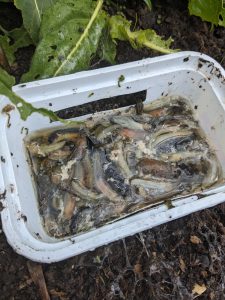
What type of slugs to I have?
In one evening, I carried out a slug spot. I identified, Grey Field Slug (Deroceras reticulatum), Western Dusky Slug (Arion subfuscus), Large Red Slug (Arion Rufus), Large Black Slug (Arion Ater), Leopard Slug (Limax Maximus), Netted Slug (Deroceras reticulatum), Yellow Slug (Limacus flavus), Green Cellar Slug (Limacus maculatus), Common Garden Slug (Arion distinctus), Brown Field Slug (Deroceras panormitanum), Spanish Slug (Arion Vulgaris), Black Garden Slug (Arion hortensis)
Where do they like to hang out?
The obvious answer is everywhere, but I found lots in the wood chip paths (newer wood chip), amongst the Docks, under and amongst the Turkish Rocket, in the wall crevices. They like the compost heap and also piles of pulled weeds. In the greenhouse & polytunnel they like to climb the walls and hide at the edges.
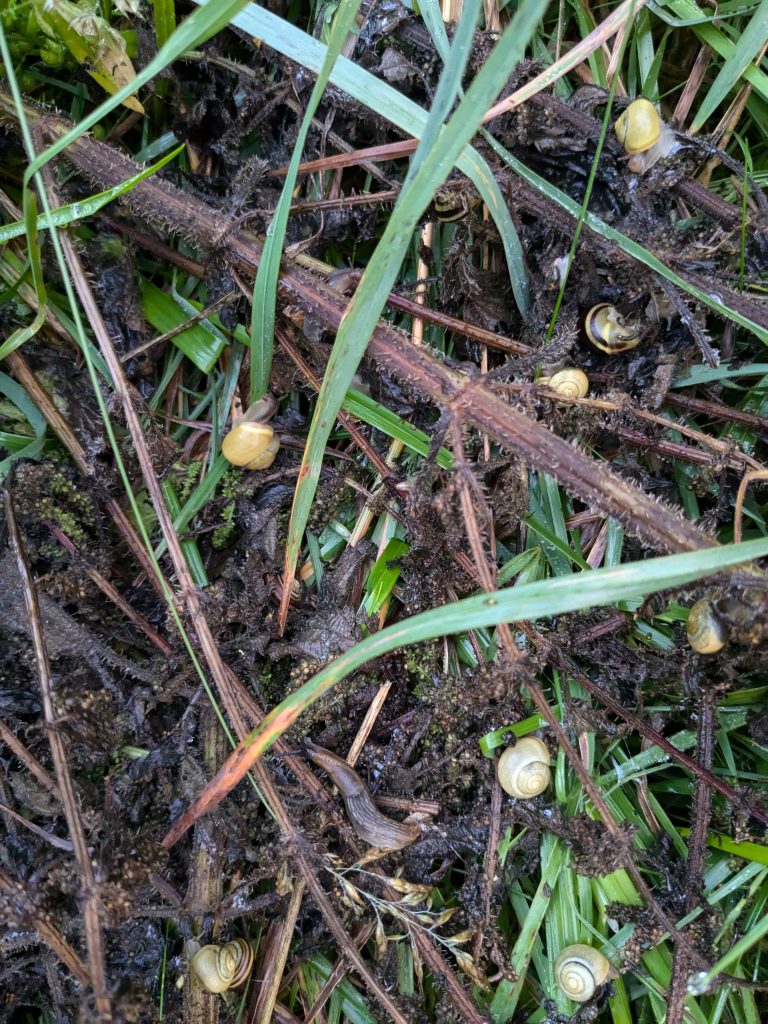
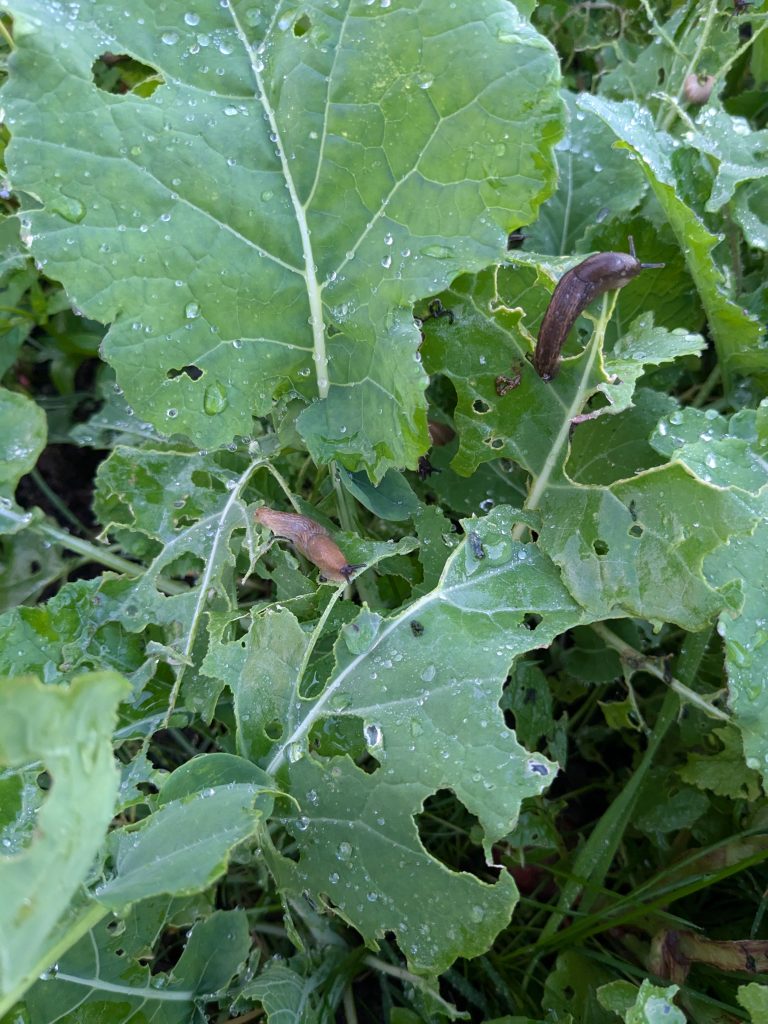
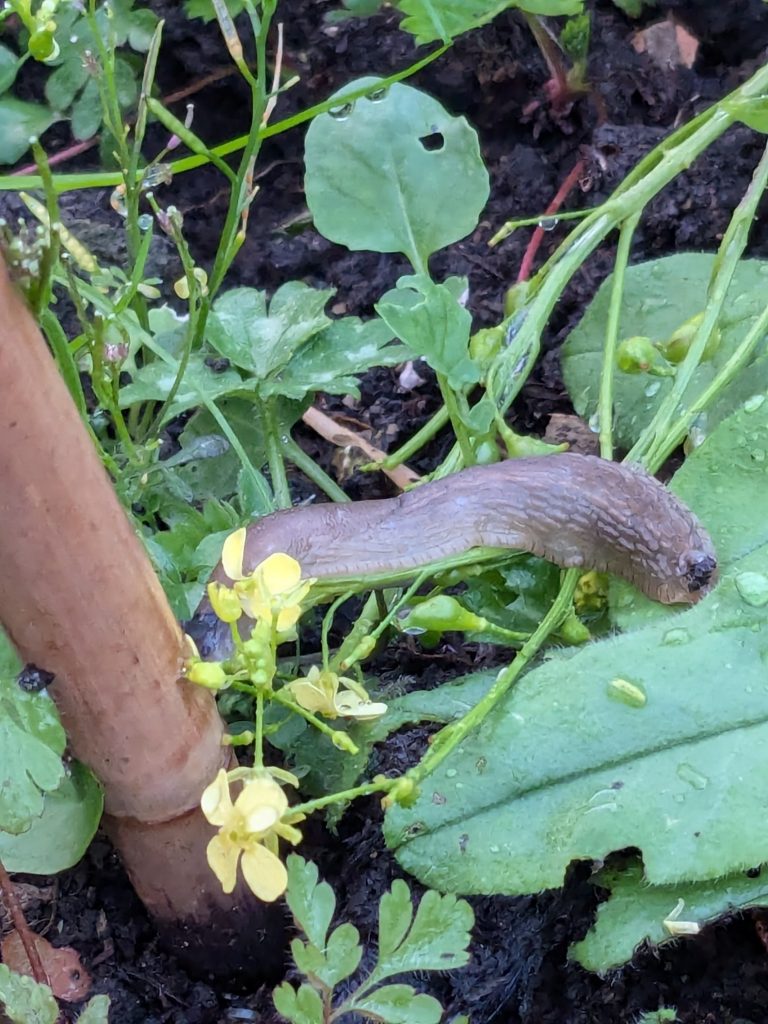
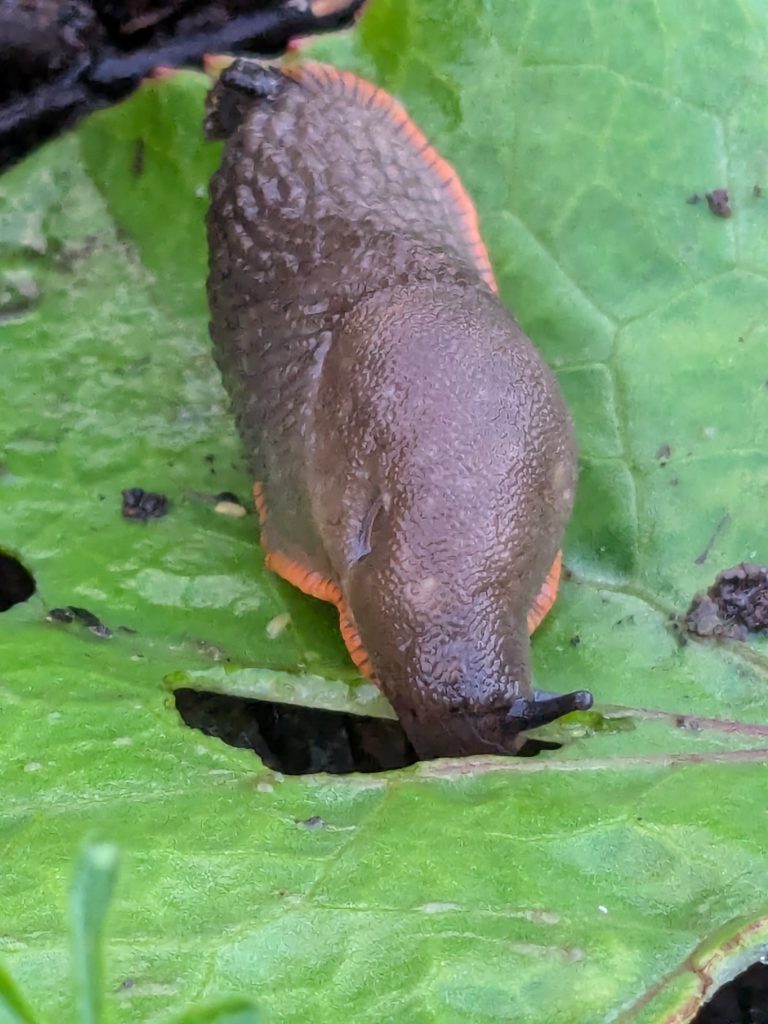
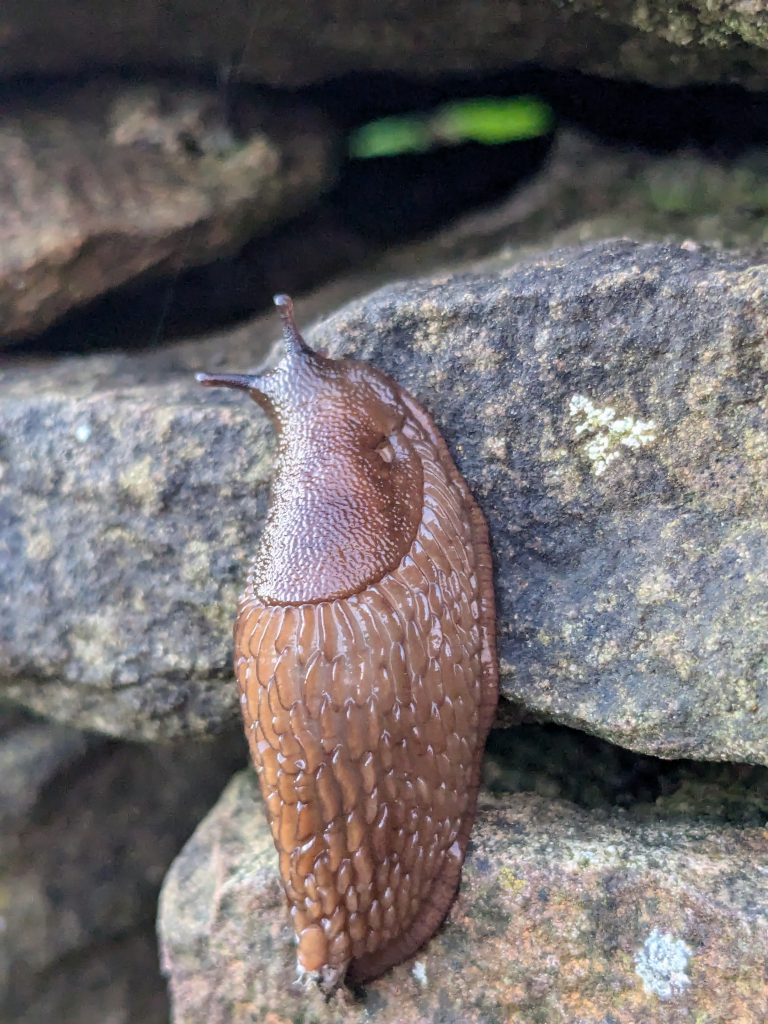
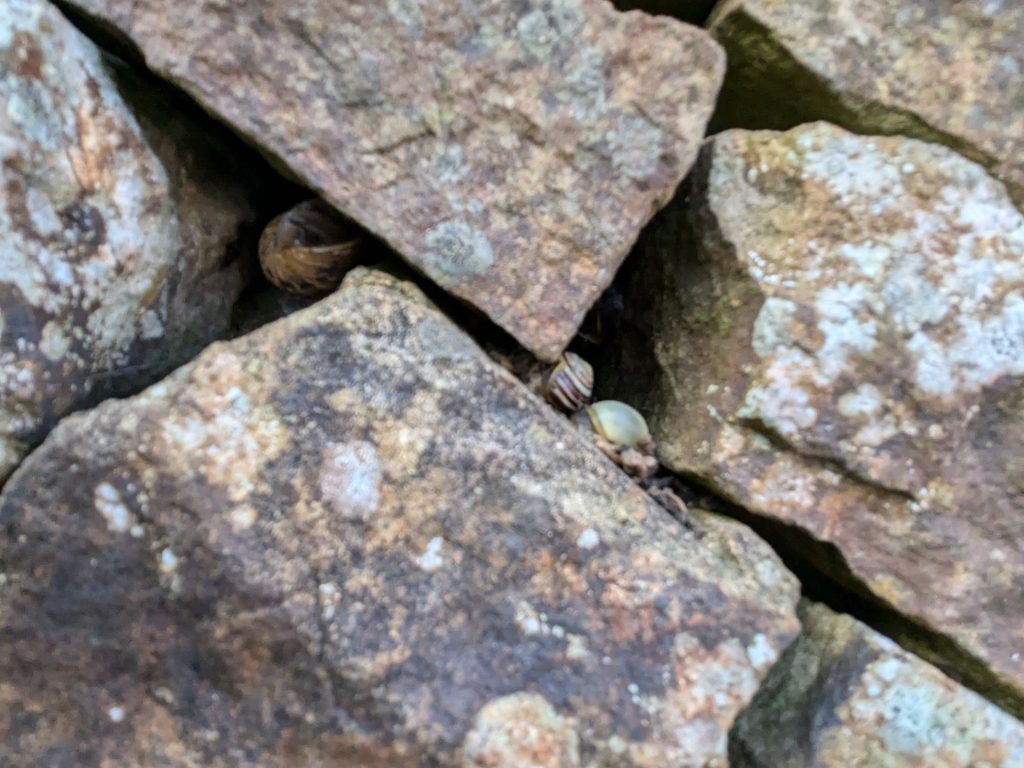
What predators did I spot?
Not too many. Mainly ground beetles, and sadly many of these had ended up in the slug traps.
Research (and investigation of ideas)
Know thine enemy
The little book of slugs was a great starting point (however I think one took it quite literally and wanted to check out my notes (look closely at the below pic)

According to the book, only four types of slugs to worry about . The field slug, The garden slug, the keel slug and the black slug. The only one of these I didn’t identify was a keeled slug. But that doesn’t mean they’re not lurking!
The book also pointed out 5 other key slug ‘lifestlye’ facts, which will help guide my design.
- Slugs need moisture for movement and memorise routes
- Slugs love dark, damp places
- Slugs love fresh new shoots and water rich plants
- Slugs need perfect mating conditions (humid and not too cold)
- Slugs can be useful – they are champion detritivores.
What predates Slugs?
Natural predators
| Rose | Thorn | Bud | |
| Hedgehog | 75% invertebrates diet (slugs, beetles, worms | Badgers on land, and have noticed remains near sett. | Include a hedgehog house or two in the design. Protect them from Badgers? |
| Frogs | Eat large numbers of slugs and snails | Need a pond for mating | Ponds attract all sorts of wildlife, and create microclimates. Favours dark damp habitat – I have plenty |
| Toads | Will eat some slugs Toads are cool | Need a pond for mating Favour beetles, woodlice and ants over slugs | Favours dark damp habitat – I have plenty. Install toad abodes |
| Shrews | Eat 80 – 90% of its weight in invertebrates including slugs and snails | Can’t think of anything bad | I have spotted shrews (dead and alive) |
| Slow Worms and grass snakes | Supposedly the most efficient slug predator | I don’t think slow worms live near me | Consider adding a sun trap to the land – might just work as a slug trap? |
| Wild birds | Pheasants and blackbirds love slugs. | Scratch up land Eat berries | Bird food garden attracts a range of birds |
| Ducks | Indian runner ducks are great at slug prevention | Need housing Need winter protection (Avian Flu) Need water (not the wildlife pond) | We already have chickens, so not too much extra work to house some ducks. Need to work out how many needed for space & how to move them about and a sheltered area for them. |
| Chickens | Eat the occasional slug | Scratch up the young plants | Use them in winter to eat pests or eggs in soil. |
Conclusion: I will further investigate whether Ducks could be introduced, but it seems sensible to incorporate more methods to attract beneficial slug predators.
Barrier methods
Barriers – The RHS has carried out some great slug barrier research Slugs and snails / RHS Gardening. which indicated that barriers just don’t work. I tried hair from the hairdresser and a layer of sheep fleece around a few plants. I can confirm that the slugs took no notice of them and carried on regardless.
Conclusion: I won’t waste money on barriers.
Trap the slugs
I did set a few slug traps around. I baited them with a mix of flour, sugar and water. The slugs actively crawled towards this, and I did trap hundreds of slugs. The result was disgusting and I felt quite sad.
The traps also trapped ground beetles and centipedes, which predate on slugs.
Ideally traps need to be checked and emptied each morning. My work doesn’t allow for this commitment.
Bran traps – Bran attracts the slugs and reportedly swells inside the slug, causing them to ‘burst’. This sounds like a horrific way to die. I can also imagine the bran attracting more rodents to my growing areas.
Conclusion: I won’t waste time and space on slug traps or use bran.
What slug products are on the market
Pellets
In 2022, traditional Metaldehyde slug pellets were banned (hoorah) as they posed a risk to hedgehogs and other wildlife. There are other “friendly” slug pellets on the market, as well as biological nematode controls.
Most of the “friendly” slug pellets now for sale in the UK use iron or Ferric Phosphate as their active slug killing ingredient. Ferric Phosphate, kills the slugs by iron poisoning. Ferric Phosphate is a very slow-acting as a poison, and it doesn’t break down easily in the slugs digestive system, so many slug killers on the market have a substance called EDTA added. This helps to make the Ferric Phosphate more soluble and fast acting.
Any introduction of poison into the foodchain is a bad thing. Slugs are a food source for many creatures.
Conclusion: I won’t use slug pellets
Nematodes
‘Nemaslug’ is a product that just targets slugs, with no adverse effect on other types of animals. It is a microscopic nematode or eelworm and is watered into the soil. The nematodes (Phasmarhabditis ermaphrodita) enter slugs’ bodies, infecting them with bacteria that cause a fatal disease. The nematodes in Nemaslug occur naturally in our soil. According to the Nemaslug website “Applying Nemaslug massively increases the number of these nematodes in the soil and tips the balance in the favour of the nematodes and against the slugs. Our environment will not support such a huge concentration of nematodes and they quickly die back to normal levels. A treatment of Nemaslug will be effective for around six weeks.
It kills all types of slug, but doesn’t kill large slugs. To be effective, moist, well drained warm soil – temperatures of 5-20ºC is required. At the time or writing a large pack of Nemaslug (treating 100m2) costs £30.
So if it costs £30 every 6 weeks per 100m2, to control slugs in my growing areas, whilst temperatures are suitable it would cost me approximately £720 per year.
Conclusion: Nemaslug is too expensive, and would also target beneficial slugs. I might consider using it in the greenhouse or Polytunnel though.
Manual removal or instruments of death
Many sources recomend torchlight searches, especially in damp weather. The slugs found are either
a) Skewered, chopped or stabbed to death or
b) collected and moved far away
Both these methods rely on me being home regularly, which often during peak slug season I am not. I don’t really want to stab and kill the slugs, but they are recycled by other slugs and detritivores. There is also a strong chance of killing beneficial slugs.
Moving slugs to the compost heap is a solution, hwever, too many may mean that the compost becomes infested with slug eggs and the problem perpetuates. I cold compost (I don’t have the time to create hot compost heaps (or money for the hot compost bins). Some slugs also have homing instincts so may return to their preferred patch!
Some people prefer to leave planks or cardboard sheets out for the slugs to hide under. I don’t have time to check and remove slugs daily,
Salting – kills slugs through dehydration. This must be an awful way to die. The salt would also build up in the soil.
Conclusion: I may on occasion do a torchlit patrol, but this will be a last resort.
Slug resistant Plants
A lot of research has gone into slug resistant plants. I created a chart that listed “slug resistant plants” found on the internet, as well as from my own experience. I then identified which of these had either a herbal, medicinal or food value, and which would grow in my climate.
Survey – Needs and Expectations Mapping
Mind-map the needs and expectations. Also needs of the habitat.
Ideas – Permaculture Principles
Principles as a source of inspiration, which can create fantastic ideas.
Mollison
Work with nature not against it
The problem is the solution
Make the least change for the most effect
Yield is theoretically unlimited
Everything gardens.